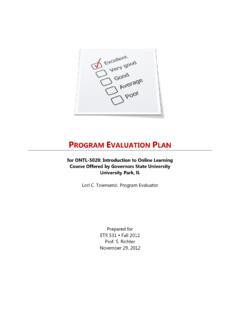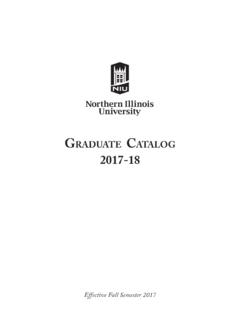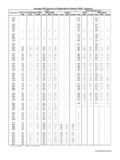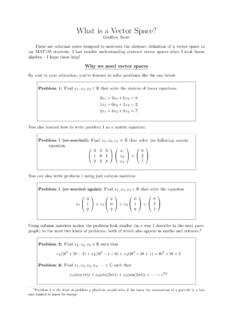Transcription of writing goals and objectives - Northern Illinois University
1 writing goals and objectives If you're not sure where you are going, you're liable to end up some place else. ~ Robert Mager, 1997. Instructional goals and objectives are the heart of instruction. When well written, goals and objectives will help identify course content, structure the lecture and guide the selection of meaningful and relevant activities and assessments. In addition, stating clear instructional goals and objectives help students understand what they should learn and exactly what to do to achieve them. A course goal may be Course goals defined as a broad A course goal may be defined as a broad statement of intent or desired statement of intent or accomplishment.
2 goals do not specify exactly each step, component, or ways to desired accomplishment. accomplish the task but they help pave the way to writing good instructional objectives . Typical course goals include a number of subordinate skills which are further identified and clarified as instructional objectives . For example, an English 101 goal might be to prepare students for English 103. The goal prepare students specifies the big picture or general direction or purpose of the course. Course goals often do not specify student outcomes or how they will be assessed. If you are having difficulty defining a course goal, brainstorm reasons your course exists and why students should enroll in it.
3 Your ideas can then generate course-related goals . Course goals often originate in the course description and should be written before developing instructional objectives . Course Goal Examples: Marketing course: Students will learn about personal and professional development, interpersonal skills, verbal and written presentation skills, understanding sales and buying processes, and developing and maintaining customer satisfaction. Physical Geography course: Students will understand the processes involved in the interactions, spatial variations, and interrelationships between hydrology, vegetation, landforms, and soils and humankind. Theatre/Dance course: Students will investigate period style from pre-Egyptian through the Renaissance as it relates to theatrical production.
4 Exploration of period clothing, manners, d cor, and architecture with projects form dramatic literature. General Goal Examples: Students will know how to communicate in oral and written formats Students will understand the effect of global warming. Students' perspective on civil rights will improve Students will identify key elements and models used in education Students will learn basic math skills Students will understand the laws of gravity Northern Illinois University , Faculty Development and Instructional Design Center , writing goals AND objectives Page | 2. Comparison of goals and objectives goals are: objectives are: Broad, generalized statements about what is to Narrow, specific statements about what is to be be learned learned General intentions Precise intentions Intangible Tangible Abstract Concrete Cannot be validated Can be validated or measured Long term Short term Defined before analysis Written after analysis Written before objectives Prepared before instruction is designed goals should be written from the objectives should be written from the instructor's point of view student's point of view Table 1.
5 Comparison of goals and objectives . Instructional objectives Once you have written your course goal you can then develop your instructional objectives . Instructional objectives are different from goals in that objectives are narrow, discrete, intentions of student performance whereas goals provide students with a global statement of intent. objectives are measurable and observable, goals are not (see Table1). Well-stated objectives clearly tell the Objectivesare objectives aremeasurable student what they have to do, under what conditions the performance takes place, by following a specified degree or standard of acceptable performance. In other measurable and and observable, goals words, when properly written, your learners will know exactly what you expect observable, are not.
6 goals are them to do and you will be able to recognize when they have accomplished the task! Generally, each section/week/unit will have several objectives (Penn State University , 2007). A common instructional objective model, developed by Heinich as cited by Smaldino, Lowther, and Russell (2008) is used by educators from a wide range of disciplines and follows the acronym ABCD: A=Audience, B=Behavior, C=Condition, D=Degree. Table 2 summarizes these characteristics. This guide will follow the ABCD model as a good starting point when learning how to derive well-stated instructional objectives . ABCD Model of Instructional objectives Audience Who will be doing the behavior?
7 Behavior What should the learner be able to do? What is the performance? Condition Under what conditions do you want the learner to be able to do it? Degree How well must the behavior be done? What is the degree of mastery? Table 2. Characteristics of the ABCD model of instructional objectives . Source: Smaldino, Lowther and Russell (2008), citing Heinich. Northern Illinois University , Faculty Development and Instructional Design Center , writing goals AND objectives Page | 3. It is good practice to write an instructional objective for each behavior you wish to measure. By using the model as illustrated in Table 1, you will easily be able It is good practice to write to fill in the characteristics to the right of each letter.
8 This practice will allow you an instructional objective to break down more complex objectives (ones with more than one behavior), into for each behavior you smaller, more discrete objectives . wish to measure. Behavioral Verbs Key to writing instructional objectives is to use an action verb when describing the behavior you intend the students to perform. Action verbs such as calculate, read, identify, match, explain, translate, and prepare all can be used to further describe the behavior. On the other hand, words such as understand, appreciate, internalize, and value are not appropriate when writing instructional objectives because they are not measurable or observable.
9 Use these words in your course goals but not when writing instructional objectives . See Verbs to Use in Creating Educational objectives (Based on Bloom's Taxonomy), at the end of this section. Overt behavior: If the behavior is covert or not typically visible when observed, such as the word discriminate, include an indicator behavior to clarify to the student what she or he has to be able to do to meet your expectations (as a written instructional objective). For example, if you want your learners to be able to discriminate between good and bad apples, add the indicator behavior sort to the objective: Be able to discriminate (sort) the good apples from the bad apples.
10 Avoid using fuzzy phrases such as to What some instructors tend to forget is to write instructional objectives from the understand, to students' perspective. Mager (1997) contends that when you write instructional appreciate, to objectives you should indicate what the learner is supposed to be able to do and internalize, and to not what you, the instructor, want to accomplish. Also, avoid using fuzzy phrases know which are not such as to understand, to appreciate, to internalize, and to know which measurable or observable. are not measurable or observable. These types of words can lead to student misinterpretations and their lack of understanding of what it is you want them to do.










